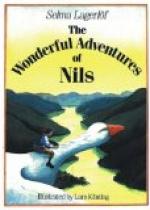After the father went away they became very poor. For awhile he sent them money, but afterward things must have gone badly with him, for no more came.
The day of the eldest daughter’s burial the mother closed the cabin and left home with the two remaining children, Osa and Mats. She went down to Skane to work in the beet fields, and found a place at the Jordberga sugar refinery. She was a good worker and had a cheerful and generous nature. Everybody liked her. Many were astonished because she could be so calm after all that she had passed through, but the mother was very strong and patient. When any one spoke to her of her two sturdy children, she only said: “I shall soon lose them also,” without a quaver in her voice or a tear in her eye. She had accustomed herself to expect nothing else.
But it did not turn out as she feared. Instead, the sickness came upon herself. She had gone to Skane in the beginning of summer; before autumn she was gone, and the children were left alone.
While their mother was ill she had often said to the children they must remember that she never regretted having let the sick woman stop with them. It was not hard to die when one had done right, she said, for then one could go with a clear conscience.
Before the mother passed away, she tried to make some provision for her children. She asked the people with whom she lived to let them remain in the room which she had occupied. If the children only had a shelter they would not become a burden to any one. She knew that they could take care of themselves.
Osa and Mats were allowed to keep the room on condition that they would tend the geese, as it was always hard to find children willing to do that work. It turned out as the mother expected: they did maintain themselves. The girl made candy, and the boy carved wooden toys, which they sold at the farm houses. They had a talent for trading and soon began buying eggs and butter from the farmers, which they sold to the workers at the sugar refinery. Osa was the older, and, by the time she was thirteen, she was as responsible as a grown woman. She was quiet and serious, while Mats was lively and talkative. His sister used to say to him that he could outcackle the geese.
When the children had been at Jordberga for two years, there was a lecture given one evening at the schoolhouse. Evidently it was meant for grown-ups, but the two Smaland children were in the audience. They did not regard themselves as children, and few persons thought of them as such. The lecturer talked about the dread disease called the White Plague, which every year carried off so many people in Sweden. He spoke very plainly and the children understood every word.
After the lecture they waited outside the schoolhouse. When the lecturer came out they took hold of hands and walked gravely up to him, asking if they might speak to him.
The stranger must have wondered at the two rosy, baby-faced children standing there talking with an earnestness more in keeping with people thrice their age; but he listened graciously to them. They related what had happened in their home, and asked the lecturer if he thought their mother and their sisters and brothers had died of the sickness he had described.




